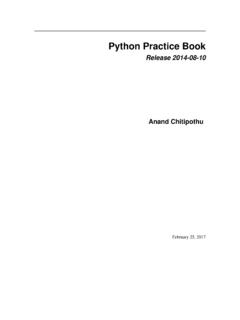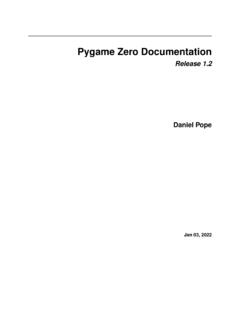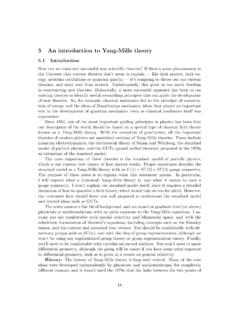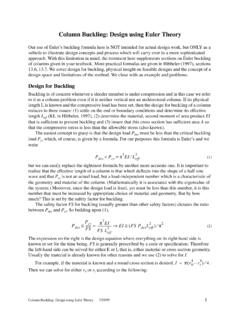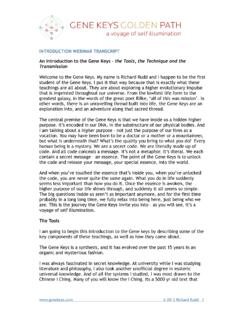Transcription of OpenCV-Python Tutorials Documentation
1 OpenCV-Python Tutorials Documentation Release 1. Alexander Mordvintsev & Abid K. Nov 05, 2017. Contents 1 OpenCV-Python Tutorials 3. Introduction to OpenCV .. 6. Gui Features in OpenCV .. 19. Core Operations .. 34. Image Processing in OpenCV .. 46. Feature Detection and Description .. 153. Video Analysis .. 189. Camera Calibration and 3D Reconstruction .. 207. Machine Learning .. 225. Computational Photography .. 250. Object Detection .. 259. OpenCV-Python Bindings .. 264. 2 Indices and tables 269. i ii OpenCV-Python Tutorials Documentation , Release 1. Contents: Contents 1. OpenCV-Python Tutorials Documentation , Release 1. 2 Contents CHAPTER 1. OpenCV-Python Tutorials Introduction to OpenCV. Learn how to setup OpenCV-Python on your computer!
2 Gui Features in OpenCV. Here you will learn how to display and save images and videos, control mouse events and create trackbar. Core Operations In this section you will learn basic operations on image like pixel editing, geometric transformations, code optimization, some mathematical tools etc. Image Processing in OpenCV. 3. OpenCV-Python Tutorials Documentation , Release 1. In this section you will learn different image processing functions inside OpenCV. Feature Detection and Description In this section you will learn about feature detectors and descriptors Video Analysis In this section you will learn different techniques to work with videos like object tracking etc. Camera Calibration and 3D Reconstruction In this section we will learn about camera calibration, stereo imaging etc.
3 Machine Learning In this section you will learn different image processing functions inside OpenCV. Computational Photography In this section you will learn different computational photography tech- niques like image denoising etc. Object Detection 4 Chapter 1. OpenCV-Python Tutorials OpenCV-Python Tutorials Documentation , Release 1. In this section you will object detection techniques like face detection etc. OpenCV-Python Bindings In this section, we will see how OpenCV-Python bindings are generated 5. OpenCV-Python Tutorials Documentation , Release 1. Introduction to OpenCV. Introduction to OpenCV-Python Tutorials Getting Started with OpenCV-Python Install OpenCV-Python in Windows Set Up OpenCV-Python in Windows Install OpenCV-Python in Fedora Set Up OpenCV-Python in Fedora 6 Chapter 1.
4 OpenCV-Python Tutorials OpenCV-Python Tutorials Documentation , Release 1. Introduction to OpenCV-Python Tutorials OpenCV. OpenCV was started at Intel in 1999 by Gary Bradsky and the first release came out in 2000. Vadim Pisarevsky joined Gary Bradsky to manage Intel's Russian software OpenCV team. In 2005, OpenCV was used on Stanley, the vehicle who won 2005 DARPA Grand Challenge. Later its active development continued under the support of Willow Garage, with Gary Bradsky and Vadim Pisarevsky leading the project. Right now, OpenCV supports a lot of algorithms related to Computer Vision and Machine Learning and it is expanding day-by-day. Currently OpenCV supports a wide variety of programming languages like C++, Python, Java etc and is available on different platforms including Windows, Linux, OS X, Android, iOS etc.
5 Also, interfaces based on CUDA and OpenCL. are also under active development for high-speed GPU operations. OpenCV-Python is the Python API of OpenCV. It combines the best qualities of OpenCV C++ API and Python language. OpenCV-Python Python is a general purpose programming language started by Guido van Rossum, which became very popular in short time mainly because of its simplicity and code readability. It enables the programmer to express his ideas in fewer lines of code without reducing any readability. Compared to other languages like C/C++, Python is slower. But another important feature of Python is that it can be easily extended with C/C++. This feature helps us to write computationally intensive codes in C/C++ and create a Python wrapper for it so that we can use these wrappers as Python modules.
6 This gives us two advantages: first, our code is as fast as original C/C++ code (since it is the actual C++ code working in background) and second, it is very easy to code in Python. This is how OpenCV-Python works, it is a Python wrapper around original C++. implementation. And the support of Numpy makes the task more easier. Numpy is a highly optimized library for numerical operations. It gives a MATLAB-style syntax. All the OpenCV array structures are converted to-and-from Numpy arrays. So whatever operations you can do in Numpy, you can combine it with OpenCV, which increases number of weapons in your arsenal. Besides that, several other libraries like SciPy, Matplotlib which supports Numpy can be used with this. So OpenCV-Python is an appropriate tool for fast prototyping of computer vision problems.
7 OpenCV-Python Tutorials OpenCV introduces a new set of Tutorials which will guide you through various functions available in OpenCV-Python . This guide is mainly focused on OpenCV version (although most of the Tutorials will work with OpenCV also). A prior knowledge on Python and Numpy is required before starting because they won't be covered in this guide. Especially, a good knowledge on Numpy is must to write optimized codes in OpenCV-Python . This tutorial has been started by Abid Rahman K. as part of Google Summer of Code 2013 program, under the guidance of Alexander Mordvintsev. OpenCV Needs You !!! Since OpenCV is an open source initiative, all are welcome to make contributions to this library. And it is same for this tutorial also.
8 So, if you find any mistake in this tutorial (whether it be a small spelling mistake or a big error in code or concepts, whatever), feel free to correct it. Introduction to OpenCV 7. OpenCV-Python Tutorials Documentation , Release 1. And that will be a good task for freshers who begin to contribute to open source projects. Just fork the OpenCV. in github, make necessary corrections and send a pull request to OpenCV. OpenCV developers will check your pull request, give you important feedback and once it passes the approval of the reviewer, it will be merged to OpenCV. Then you become a open source contributor. Similar is the case with other Tutorials , Documentation etc. As new modules are added to OpenCV-Python , this tutorial will have to be expanded.
9 So those who knows about particular algorithm can write up a tutorial which includes a basic theory of the algorithm and a code showing basic usage of the algorithm and submit it to OpenCV. Remember, we together can make this project a great success !!! Contributors Below is the list of contributors who submitted Tutorials to OpenCV-Python . 1. Alexander Mordvintsev (GSoC-2013 mentor). 2. Abid Rahman K. (GSoC-2013 intern). Additional Resources 1. A Quick guide to Python - A Byte of Python 2. Basic Numpy Tutorials 3. Numpy Examples List 4. OpenCV Documentation 5. OpenCV Forum Install OpenCV-Python in Windows Goals In this tutorial We will learn to setup OpenCV-Python in your Windows system. Below steps are tested in a Windows 7-64 bit machine with Visual Studio 2010 and Visual Studio 2012.
10 The screenshots shows VS2012. Installing OpenCV from prebuilt binaries 1. Below Python packages are to be downloaded and installed to their default locations. Numpy. Matplotlib (Matplotlib is optional, but recommended since we use it a lot in our Tutorials ). 2. Install all packages into their default locations. Python will be installed to C:/Python27/. 3. After installation, open Python IDLE. Enter import numpy and make sure Numpy is working fine. 4. Download latest OpenCV release from sourceforge site and double-click to extract it. 7. Goto opencv/build/ folder. 8 Chapter 1. OpenCV-Python Tutorials OpenCV-Python Tutorials Documentation , Release 1. 8. Copy to C:/Python27/lib/site-packeges. 9. Open Python IDLE and type following codes in Python terminal.

